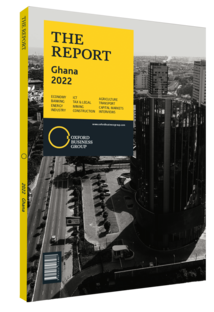How the Ghanaian government is supporting community mining
Artisanal and small-scale mining (ASM) is a major driver of the economy, directly employing an estimated 1m Ghanaians and supporting around 4.5m others. ASM – categorised by concessions of under 4000 sq metres – has accounted for around onethird of the country’s total gold output in recent years. “Almost all the jewellery worn in Ghana is manufactured with gold coming from ASM,” Frank Boateng, vice-dean in the office of research, innovation and consultancy at Ghana’s University of Mines and Technology, told OBG. “A wide swath of the population’s livelihood is supported by the sector. Not only miners, but also people selling food and water at sites, equipment companies and machine operators.”
However, ASM has traditionally struggled with poor working conditions, a lack of access to finance and outdated practices. Some ASM fields have also been cited for major environmental degradation, the spread of pollutants such as cyanide and mercury, deforestation and water contamination. Even so, they play a key role in the economy. The government has prioritised formalising the segment, as well as cracking down on illegal small-scale mining known as galamsey – derived from “gather them and sell.”
Regulations & Enforcement
The Small-Scale Gold Mining Act of 1989 legalised small-scale mining pending the purchase of a licence, and the Minerals and Mining Act of 2006 determined that ASM licences could only be issued to citizens over 18 years of age. In practice, however, ASM operations often lack formal licences, but have been accepted by a local community or chieftain. As such, both formal and informal entities operate in the space – a fact that reform initiatives take into account.
In 2017 the government created the Inter-Ministerial Committee on Illegal Mining (IMCIM) to coordinate efforts to reform ASM. The body aimed to strengthen the regulatory framework around ASM and enhance the capacity of agencies involved in the segment. Several security operations aimed against illegal mines were implemented, with police confiscating equipment. Moreover, the government banned smaller mining operations in 2017 and for much of 2018, which gave the government time to accredit and register artisanal miners.
Reforms
In late 2021 President Nana Akufo-Addo launched the National Alternative Employment and Livelihood Programme (NAELP) to assist communities affected by crackdown operations. It included six pillars: land reclamation and reforestation; the development of agriculture and agro-processing activities; apprenticeships, skills training and entrepreneurship; sustainable small-scale community mining; sector support services; and community development.
Even though the IMCIM was dissolved in January 2021, the government has continued to prioritise formalising small-scale mining operations. Community mining schemes, first rolled out by the IMCIM and later integrated into the NAELP, have been central to recent government efforts. These schemes aim to bolster the participation of residents of host communities in small-scale mining operations, while cracking down on illegal practices. Mining areas covered by the programme will feature on-site environmental officers, sick bays and modern office facilities. As of November 2021 the government had approved five community mining schemes with a combined 20 concessions that had the potential to support the livelihood of 26,300 people. The government aims to approve 100 such schemes by the close of 2022, creating 220,000 jobs.
In addition, the Minerals Income Investment Fund was established in 2018 to manage the national interest in mining companies. Part of its financing goes towards providing technical support and long-term capital for viable ASM activities. Currently, much of ASM’s financing is informal, with miners receiving funds or equipment in return for a share in profits.
You have reached the limit of premium articles you can view for free.
Choose from the options below to purchase print or digital editions of our Reports. You can also purchase a website subscription giving you unlimited access to all of our Reports online for 12 months.
If you have already purchased this Report or have a website subscription, please login to continue.

